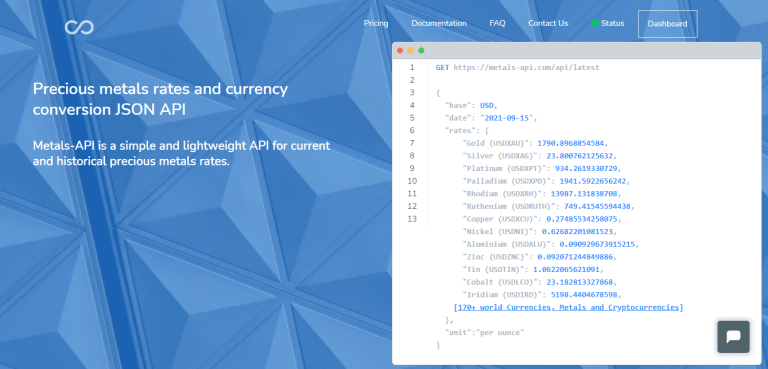If you’re looking to obtaing updated metal prices with Python, read this article and learn how to do it!

Information about the currently traded metals and their current price is an extremely important aspect of business for anyone involved in the metal industry. The metal market features a wide range of different metals that are tracked on a daily basis. Some of the more commonly traded metals include steel, copper, iron, aluminum, zinc and lead. There are also metals on the market that can be considered precious like gold, silver, platinum and palladium.T he metals market is dynamic and constantly changing. We are there to keep you updated as the prices of metals fluctuate.
To be competitive in this industry, you must monitor its regular price. By paying attention to current pricing, you can determine the best moment to invest. As a result, if you’re searching for a solution to keep up with these rates in Python, you should use an API. t all Metals APIs have different metals and all rates available from the Americas and the world. The only free & paid API that does it is Metals-API. It is not only the most used in countries such as India and Russia, of the largest producers of precious metals but also in parts of America.
Why Python?
Python is a high-level, general-purpose programming language that is interpreted by the processor. Its design approach uses a lot of indentation to help with code readability. Its features and object-oriented approach are also meant to assist programmers in writing clean, logical code for both small and large-scale projects.
1) GET YOUR METALS-API API KEY
- Go to https://metals-api.com/ and press GET API KEY in the top right corner
- They have a range of plans, but we’ll begin with the free one for this instance. Select Get API Key from the drop-down menu.
- You’ll be required to create an account, after which you’ll get a verification email. You will be driven to the most recent Metals-API dashboard when you click on the email to check your account. Click the ‘Dashboard’ button in the left-hand sidebar.
- Your API access key should now be visible to you. Make a copy of it and safely store it; we’ll need it later. The Metals API is now available to you.

2) CREATE YOUR API REQUEST
There are 5 main API Endpoints through which you can access different kinds of data, all starting out with this Base URL:
Simply attach your unique Access Key to one of the endpoints as a query parameter:
- API root: https://metals-api.com/api
- Endpoint: /latest
- Query strings: ?base=USD&symbols=XAU,XAG&access_key=YOUR_ACCESS_KEY
When we bring it all together, we get the full API Request URL:https://metals-api.com/api/latest?base=USD&symbols=XAU,XAG&access_key=YOUR_ACCESS_KEY
- Latest rates endpoint: Returns real-time exchange rate data for all available or a specific set of currencies.
- Convert endpoint: This allows you to convert any number from one currency to another.
- Historical rates endpoint: Returns historical exchange rate data for all available currencies or a selection of them.
- Time-Series data endpoint: Returns daily historical exchange rate data between two specified dates for all available or a specific set of currencies.
- Fluctuation data endpoint: Returns fluctuation data between two specified dates for all available or a specific set of currencies.
READ MORE:
Get Hourly XCU Prices in USD with an API for Free – TheStartupFounder.com

